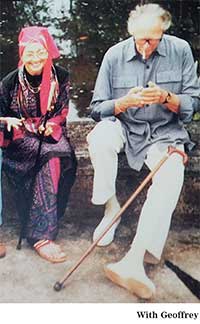Midweek Review
Exploring with Ena

by Prof Rajiva Wijesinha
published by S. Godage & Bros, 661 P de S Kularatne Mawata, Colombo 10
This is a very unusual book, hard to characterize as to genre but encompassing a sweeping and illuminating description of Sri Lanka: its outstanding physical beauty, social change over the years, political history (and declining standards) and a range of fascinating personal relationships. These involve a host of exciting individuals though easily the most enthralling is the bond between Ena de Silva and her not so closely related grand nephew, the author.
The narrative itself proceeds like a journey, albeit not an onerous one and one that moves with ease. Its characters breeze in and breeze out, with the author and the Ena character staying fixed and giving what would otherwise seem mere entertaining fluidity much required shape. So they remain its anchors, as it seeks to explain the ease of life and pace of a country blessed with natural beauty, history and culture.
It is a deeply personal tale of a developing relationship between a great aunt and a grandnephew. At the conclusion this has seasoned into a bond of friendship that has transcended the generation gap. It is perhaps the maverick in the Ena make-up so clearly illustrated by the author that allows her to flow through the generational divide, touching and influencing the like-minded no matter whatever their ages were. The author’s flirtation with politics and his losing battle to short-sighted politicians when aiming for educational reform, and the sense of frustration arising therefrom, highlight the degenerating standards and outlook of a changing society.
It is also semi-biographical of the life and times of Ena De Silva, although it is not written in the form of a biography but as a series of amusing trips, journeys, visits, escapades or call them what you may which the author delighted in with the iconic Ena De Silva as a more than willing accomplice. Her character, traits, humour, wit and accomplishments all get conveyed in the various episodes from an early account of her eloping with her future husband even as a minor to her deeply evolved creative commitment and her colourful sense of fashion.

There are also splendid set pieces such as the outdoor wedding scene in the gardens where little bells are hung about so that they could ring out melodiously, even long after the wedding was over, even to the day the grand old lady breathed her last when the final bell hanging loosely somewhere decided it was time to slip off.
The changing political landscape itself, not for the better but for the worse with the creeping in of authoritarianism, opportunism and chauvinism, is represented through actual historic events and occurrences. Ena’s deeply critical outlook towards the Presidency of J.R. Jayawardene resonates with the author’s own views but remains outlandishly unpopular with their almost blindly loyal UNP families.
Yet neither the author, and even less Ena, has the slightest reticence in either containing or confining their views, which needless to say is the cause for much consternation in their family circles. The collection of other prominent Sri Lankan characters woven into the account through their interactions with Ena and the author lends an additional sparkle to the narration. The sudden appearances of Richard De Zoysa, Michael Ondaatjee, Laki Senanayake, Nigel Hatch and Geoffrey Bawa, to mention just a few, opens up additional interest to a Sri Lankan audience.
The author’s frequent mention of beautiful scenery and wonderful natural and cultural experiences, alongside gastronomically extravagant feasts that Ena brings on almost effortlessly, recreates in the mind of the reader the zest for life and living which the late Ena De Silva shared with the author. The staff such as Suja, who tends to grow in girth as Ena’s banquets get grander and grander still, and Karim the chauffer excellent at all things except driving, add subtle humour which is infused almost carelessly.
This book records an exceptional Sri Lankan of yesteryear and is primarily for a Sri Lankan audience or at least one with a more than passing acquaintance of the island. But then some stories are for the world, and others for a privileged few. This book falls into the latter category.